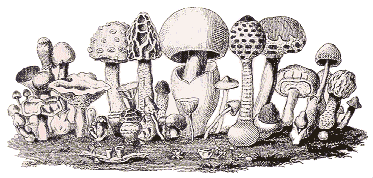
Thursday 6th January
A lull in the frosty weather, so I went for a walk round a National Trust wood. Very neat and tidy. I was surprised at the number of fungi still around. Lots of Mycena galericulata (Common Bonnet). One fallen tree was covered with Cudoniella acicularis (Oak Pin) and another with Bulgaria inquinans (Black Bulgar). Neobulgaria pura var foliacea was also present. This wood has a lot of Beech trees. I must go again soon.
Tuesday 11th January
Weather good enough for gardening today. My blackcurrants have some dead branches upon which tiny black cushions are breaking through the bark. My conclusion is Dothiora ribesia, which is not good news for the blackcurrants. Still struggling with a couple of the Corticioid (crust) fungi found in the woods. Frustratingly, I can not find any spores. I did manage to identify a Myxomycete (Slime Mould), Trichia scabra.
Friday 14th January
A sunny day at last. I went to check on my fallen trees and branches now that the undergrowth has died back. Lots of new brackets growing. I collected a few that I could not identify on site but have not yet started to look at them in detail. I was surprised to find a Hygrophorus hypothejus (Herald of Winter). Methinks he got his timing wrong.
Sunday 23rd January
A bit quiet at the moment. Played golf this morning and came across a large patch of Tubaria furfuracea (Scurfy Twiglet). Until recently, the winter version was named Tubaria hiemalis, because it had capitate cystidia. I once collected dozens to examine under the microscope and found some had capitate cystidia, some did not and some had both. I never understood the difference so was not surprised when they lumped them all together.
Friday 28th January
For a change, I decided to see if I could find any microfungi amongst the Yew trees. A collection of dead leaves was covered with little black spots. Trying to dig one out for the microscope was difficult but I eventually succeeded in identifying the spores of Botryosphaeria foliorum, as shown in Ellis & Ellis. Hundreds of colourful Flummulina velutipes (Velvet Shank) on the fallen Beech trees. Another box of bits of dead wood to look at.
Sunday 6th February
Joined my friend, Fungalpunk Dave who leads the Cheshire & Clywd Group, for a foray at Moore Nature Reserve. We did well. 40 species so far, incluing Phellinus ignarius (Willow Bracket), Melanotus horizontalis (Wood Oysterling), Mycena olida (Rancid Bonnet) and Lanzia firma (Brown Cup). More boxes of bits and pieces of twig still to examine. Wasn't it windy?
Wednesday 9th February
Finally finished looking at the collection from Sunday. Between us we identified 49 species. Not bad for early February.
Thursday 10th February
Had a look round the grounds of Sudley Hall. It has some excellent old beech trees and is very good for Russulas (Brittlegills). I did not visit last year. I found Peniophora incarnata (Rosy Crust) and a new on for me, Peniophora violacealivida. This one is violet coloured and has lots of setae (hairs) which you can just see with a powerful hand lens. Sadly the Council have been out clearing up all my fallen branches. There was very little left in their clean and tidy grounds. Hopefully all the budget cuts will mean they will not have the money to do it this year.
Monday 14th February
Lots of Coprinellus micaceus (glistening Inkcap) growing on and around old tree stumps at the golf course. I also spotted Inonotus hispidus (Shaggy Bracket), high up on an Ash tree. The Club had to cut off the branches and the top of this tree after one of the branches snapped and nearly hit one of the golfers. The fallen branch was growing a Shaggy Bracket. This was in 2000, so it has taken over 10 years to appear again.
Tuesday 15th February
A large Ash tree was blown over in the gales last week. Some fungi, such as Inonotus hispidus (Shaggy Bracket) grow in the tops of large trees so the only time you see them is when the tree or a branch comes down. I went along to inspect it. Although there were masses of fungi growing down the trunk, it was immature and I could not find any spores to identify it. All I could identify were Dacrymyces stilatus (Jelly Spot) and Daldinia concentrica (Cramp Balls). The Council will now cut it up and take it away, so I will not get another chance.
Sunday 20th February
A frustrating time of year. Nothing much is growing in this cold weather. I did my final pruning of my fruit bushes today. Some of the dead stems of the blackberry and raspberry had little black fungi poking through. No sign of any spores. Could be Diatrype, Leptosphaeria, Diaporthe. I had to give in.
Wednesday 23rd February
I cut out the dead stems of a variegated Carex riparia and noticed small black spots poking through. So I put them under my microscope and this time got lucky. I have no idea what the spots were but did identify spores from Stagnospora paludosa which is said to be common. There was definitely another spore there but I could not find it it my books. I am clearly getting desperate.
Saturday 12th March

Sorry to be missing for a couple of weeks but I went on a cruise to The Arabian Gulf. Not many fungi in the desert. However, the restaurant on the ship did have some excellent decorations just to stop me from being homesick.
Wednesday 16th March
I have not seen any fungi despite the fair weather. I picked some daffodils and noticed some purple spots on the leaves which I identified as Stagnosporopsis curtisii. But that is the best I can do at the moment.
Sunday 20th March
A fallen tree was cut up into ten sections by the local Council and they were then positioned to mark out a path at the golf course. On one of these tree sections grew Hericium cirrhatum (Tiered Tooth). Last week the Council removed one of the tree sections and covered it with soil to make a barrier to stop people driving cars onto the golf course. Guess which one they took?
Saturday 26th March

My neighbour on the allotments had been forcing his rhubarb by covering it with a tarpaulin. Yesterday, when he took it off, all the straw, leaves and twigs under this tarpaulin, were covered by masses of a Myxomycete (slime mould). I eventually identified it as Badhamia foliicola. The clincher was the tiny yellow stalk. I could not see it with a hand lens but it was obvious the sporangia (fruitbody) was not flat on to surface. Using a microscope at x 40 magnification, I was able to photograph it.
Saturday 2nd April
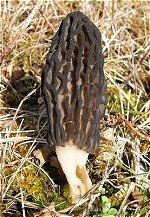
As I am leading a foray at Ainsdale Sand Dunes Nature Reserve next Sunday, I decided to have a quick look round this morning. Despite the recent rain, there was not a lot of growth but perhaps it is to soon for the rain to take full effect after such a long dry spell. I did count eleven Morchella elata (Black Morel).
Monday 4th April
Golf this morning. Calocybe gambosa (St.Georges Mushroom) in a large group. Quite early this year. Also Coprinopsis atrametaria (Common Inkcap), which is used as a preventative for alcoholism as it makes you ill if you eat them and drink.
Friday 8th April
I went to Speke Hall to see if morels grew there. They did not. I found a large patch of mushrooms in the wood which I identified as Agaricus macrocarpus. Very early for this species. Apart from some Entoloma sericium (Silky Pinkgill) on the Geat Lawn, there was nothing else to collect.
Sunday 10th April
I led my foray to Ainsdale Sand Dunes. After a long route march, sixteen of us arrived at the dune slack where we counted sixteen Morchella elata (Black Morel), although studies show that there is not a great difference between this and Morchella conica, if any. We also found Gyromitra ancilis, sometimes and confusingly known as Pig's Ears. (Two other species of fungi also have been given this name). Verpa conica (Thimble Morel) was also present. It was very warm and very dry, so not much else was colected.
Friday 15th April
I went for a quick walk to look at one of my favoured sites at the local golf course. We have not seen rain for two weeks so it is very dry. All I found were some very dry Tubaria furfuracea (Scurfy Twiglet) and a nice group of Polyporus squamosus (Dryad's Saddle). Please rain.
Saturday 30th April
After six weeks of sunshine and no rain, there is nothing to be seen. Yesterday, the Council workmen were cutting branches from a large Oak tree which grows on the grass verge of one of the local roads. This tree also supports a massive Laetiporus sulphureus (Chicken of the Woods). When I asked why they were not felling the tree, I was told that the residents had objected to this. They will certainly object when it falls on their heads.
Monday 16th May
Just returned from an Ascomycete Workshop run by the British Mycological Society. These are the ones that shoot their spores from tube and are mainly very small. Lots of interesting speakers from Europe. Finding examples to look at was difficult as the ground was still dry despite the recent rain. A few spots on leaves and sticks. The best I found was the tiny Lachnum apalum (Rush Disco). One compensation was that we were at Wentworth Castle, near Barnsley, which is home to national collections of azaleas and rhododendrons. Very beautiful at this time of year although I did spot some Pycnostysanus azaleae (Rhododendron Bud Blast).
Sunday 29th May
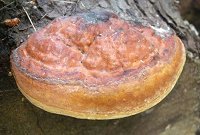
Just got back from a holiday in Dalmatia. Very hot at 30degC. I still managed to find a fungus and what a beauty. I was not allowed to pick it as it was in a protected nature reserve on an island named Lokrum. I had to lie on my back to see underneath which was orange with pores. My best guess is Pycnoporus cinnabarinus. Very very rare in the UK. I had a quick look locally this afternoon but all I found was a Reticularia lycoperdon (Bark Puffball).
Thursday 2nd June
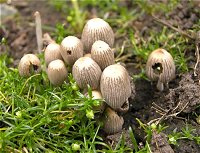
I found some fungi growing on an area of damp bare soil behind my garage. After much hard study, I have identified them as Parasola leiocephala. Said to be very common but you will not find them in many of the popular books. Could this be the start of the fungi year?
Friday 3rd June
I went to look at those Parasola leiocephala this morning. They have all completely disappeared. It shows how fleeting some of these fungi are and how lucky you are to come across them at the right moment.
Tuesday 7th June
Played golf at Leigh today. Very attractive course. It was once an educational establisment for young ladies and is over 100 years old, so there are lots of mature trees. I found some Ganoderma pfeifferi (Beeswax Bracket) growing from some old Oaks but they were past their best. Also Polyporus squamosus (Dryads Saddle) on a stump.
Saturday 11th June
Much excitement. My next-door neighbour found a faerie ring on her lawn and rushed round to ask me what it was. It was the usual Panaeolina foenisecii (Brown Hay Cap). I know it is common but it is the first gilled fungus I have seen for ages. I duly identified it. I may have attracted another convert.
Sunday 12th June
Joined the North West Fungus Group at Rivington, once the country estate of the industrialist, William Lever of Sunlight Soap fame. It was still dry but we turned up a few specimens, including an early Russula parazurea (Powdery Brittlegill). Also found was Fomes fomentarius (Hoof Fungus) on a fallen Birch, a first for the site. On the end of a piece of branch, I found a very tiny specimen, which I later identified as Simocybe haustellaris (one of the Twiglets). Described as rarely reported but apparently widespread. Not surprising as it was only 2mm big. I was lucky to spot it.
Wednesday 15th June
At last I have found some fungi at my golf course. Bolbitius titubans (Yellpow Fieldcap) was growing with woodchip. This is unusual as it is usually associated with dung and grass. This is very fresh woodchip so perhaps the fungus is growing from something underneath it. I have a note that it will grow with sawdust.
Friday 17th June
As I passed our lone Pine tree on the golf course, I saw that a piece of bark had dropped off. I picked it up in hope. There were a few holes which suggested a fungi might have been at work. When I got it home I noticed a a flap which I lifted and lo and behold. Nectria pinea. Not one I have seen before but I have never looked.
Saturday 18th June
I found some 'small brown jobs' on the path at my allotment. I thought it would be Panaeolina foenisecii. However, it did not have the expected spotted spores. Instead, they were finely roughened but definitely not smooth. My conclusion is Panaeolus olivaceous. The Checklist says it is widespread but rarely reported. This probably is because you have to look very carefully to see fine spots which can easly be missed. Also the cap is dull, greyish and wrinkled.
Sunday 19th June
I represented the fungi world at a Bioblitz held at Scutcher's Acres near Ormskirk. Despite the recent rain, it was still very dry, Not many gilled fungi about although one small wood produced three different Pluteus species. Pluteus cervinus (Deer Shield), P. salicinus (Willow Shield) and the pretty, yellow P. leoninus (Lion Shield). One that intereted me was Calcarisporium arbuscula, a parasitic fungus on Xylaria longipes (Dead Molls Fingers}. A new find for me.
Tuesday 21st June
I am still working on some of the specimens I brought back on Saturday. The wood had hundreds of Marsh Orchids and I found a rust on one of them. The spores suggested Puccinia sessilis. Another interesting find was of Lachnum niveum growing on Peniophora limitata. I cannot find any reference to a connection between the two in the literature. Perhaps it was just coincidence.
Wednesday 22nd June
Went for an early morning walk. While passing through a gloomy piece of woodland I was surprised to find a group of white Pleurotus pulmonarius, shining like beacons. This is the less well known of the Oyster mushrooms and usually fruits during the summer. No-one seems to have given it an English name yet. On the next fallen tree was Fuligo septica, the bright yellow Myxomycete. A colourful morning.
Friday 24th June
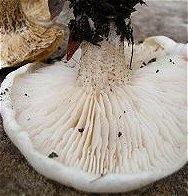
Walking through my local park last night, I passed some flowerbeds which had been mulched with a mix of woodchip and leaves in the autumn. I saw some white fungi and picked one but it was too dark to examine. At home, I looked at it and saw that the stem had black warts. I suspected Melanoleuca verrucipes (Warty Cavalier) but could not find the 'stinging nettle' cystidia to confirm. So back I went this morning for some more and found the necessary bits. This is one of those fungi which is moving north and therefor unusual for Liverpool. Also collected were Volvariella gloiocephala (Rosy Stubblegill).
Saturday 25th June
I contacted Kew Herbarium about my Menoleuca verrucipes (Warty Cavalier). Apart from one they received from another North West Fungus Group member which was found at Darwen in 2009, all of their specimens are from the south east of England. I have been asked to send my samples to Kew so they now have to be dried and posted. I spoke to my colleague who told me they never reappeared on his site. We believe that the condition of the woodchip is important for the fruiting. My patch of woodchip was laid down last autumn. I shall keep watch to see if they come again.
Monday 27th June
At last a fungus at my golf course. But only one. Leccinum duriusculum (Slate Bolete) was growing under Populus tremulla (Aspen). This species grows in good numbers every year. Interestingly, this is the earliest date I have ever found it. By two weeks.
Tuesday 28th June
Yesterday, having found a Leccinum that was fruiting two weeks earlier than usual, this morning I found a lone Calocybe gambosa (St. Georges Mushroom). This much later than the usual growing time. Where has it been hiding?
Tuesday 5th July
Another hot dry spell and the fungi have all but disappeared. Only two Agaricus arvensis (Horse Mushroom) hiding in some long grass at the Golf Course. Do not ask what I was doing in the long grass. However the weather forecast looks hopefully wet. My allotment needs it as well, especially the peas.
Sunday 10th July
Following a week of heavy rain, I and a colleague went to Ainsdale Sand Dunes Reserve to see if any fungi had been encouraged to grow. It was still very dry and all of our finds came from one small damp wood. A hands and knees day. We still managed to find nearly 40 species. Most interesting were a couple of species growing on insects. We found 2 dead Craneflies covered with a white fungus which my colleague identified as an Entomophaga species. Even better was a Cordyceps forquignoni which he dug up to find it still attached to the dead fly.
Wednesday 13th July
I have just finished looking at the specimens I brought back from Ainsdale. One was a problem. A nice red-brown Conocybe produced some very large spores, up to 19um. There are two Conocybes in my books with spores this size, C. pubescens and C. rubiginosa. The deciding factor is the basidia, pubescens is 4 spore, rubiginosa is 1 or 2. Unfortunately the basidia is fat and round making it very difficult to see the very short sterigmata. After eight attempts, I managed to locate more then two so the conclusion is Conocybe pubescens. As it was found in a paddock in which they keep sheep, this was a logical conclusion.
Thursday 21st July
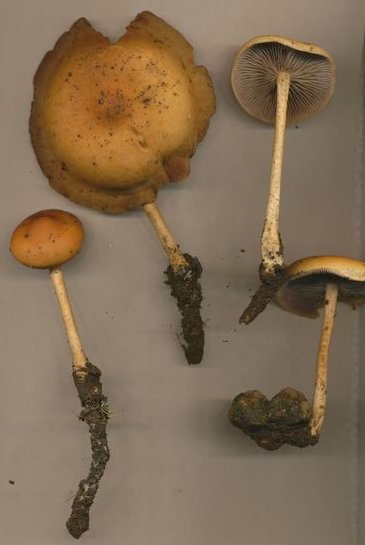
Today I received a message from Dr. Brian Spooner of Kew Herbarium about an unusual fungus I found on my allotment site.
'Just a follow-up to the undetermined rooting agaric. I need to re-examine the specimen to check the chrysocystidia but this seems to be Hypholoma tuberosum Redhead, described from Vancouver in compost – so an alien there too! It has similar rooting base and sclerotium, and spores are OK. It would be new to Britain, so an interesting find and worth collecting more if it turns up again, and of course writing up if I can confirm it.'
I am quite proud of my discovery and hope that my experience will encourage you to persevere. You just never know what you might find.
Friday 22nd July
I googled Hypholoma tuberosum and found an Australian website at http://www.anbg.gov.au/fungi/mycogeography-imports.html. It seems that peat may be a key factor in its growth. It could therefore pop up anywhere as peat has been a common product used in allotments and any gardening operation. However, gardeners are now being encouraged to avoid peat products to save that particular environment. It could happen that this fungus could be become extinct in this country and we have only just found it.
Saturday 23rd July
As it was a nice evening, I went for a walk round the local park to see if anything was growing in the flowerbeds. Lots of Psathyrella but not much else. Beneath an oak tree, I came across a small group of squat Agaricus with scaly caps. Not the most attractive of specimens. The stems had a root and when cut turned orange. The cap, spores and ring fitted Agaricus lanipes. Not one I had knowingly seen before but Agaricus is a difficult genus.
Saturday 30th July
I played in a golf competition this morning. It was oppressively hot. Despite having seen no rain for over a week, there was a fair number of Leccinum duriusculum (Slate Bolete) under the Aspen. I also found a lone Russula cyanoxantha (Charcoal Burner). Although common elsewhere it is only the third time I have found it on my golf course in twenty years.
Monday 1st August
I played golf at Woolton Golf Course, in Liverpool, today. Although it was very dry, I still managed to find a couple of Amanita rubescens (Blusher) and a Paxillus involutus (Brown Rollrim). However, the star find was of Boletus edulis (Penny Bun), which would have been Boletus reticulatis, if it still existed. It was very small. I thought it would make breakfast until I started to cut it up. The maggots won.
Tuesday 2nd August
Someone is doing a survey to find out the prevelance of the rusts Puccinia arenariae and Puccinia behenis on Red campion. So I went out to find some. All of mine were arenariae, which is the common one. Apart from a large group of about fifty Coprinopsis lagopus (Haresfoot Inkcap) on a pile of woodchip there was nothing else around.
Wednesday 3rd August
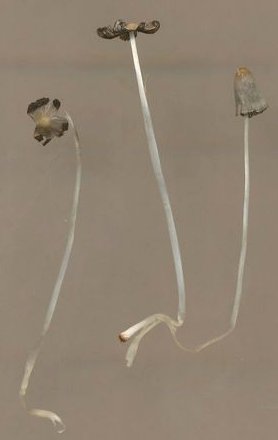
I was up at 6 a.m. this morning. I went out into the garden to fill the bird feeders and discovered that my lawn was covered in tiny Inkcaps. I identified them as Coprinopsis friesii from the rhomboid spores and the shape of the cystidia. I have found them on the law in previous years. Interestingly, by the time my wife got up at 8 a.m. they had all disappeared. It makes me wonder if there are any other unknown tiny fungi with similar habits waiting to be discovered by an early riser.
Thursday 4th August
A friend of mine telephoned me as he had found lots of mushrooms in his garden. Could I identify them. I went round to his house where he had a box of Russula ionochlora (Oilslick Brittlegill). He really wanted to know if he could eat them for breakfast. I never advise on edibility, even though they are. He has achieved the age of 80 so I do not want to be the one to finish him off. As I was passing the park on my way home, I found some more under the Beech trees.
Sunday 7th August
Sadly I could not get to the North West Fungus Group foray at Moor Piece. As usual, I missed a good day. They found a Stinkhorn, Dictyophora indusiata (Netted Stinkhorn). It is not supposed to be a British species, so what was it doing in the western Pennines?
Monday 8th August
Avoiding the rain showers, I went for a walk round my local parks. Things are starting to grow. I found Russula atropupurea (Purple), sororia (Sepia) and delica (Milk White Brittlegill). Also a very large Boletus luridiformis (Scarletina Bolete) under a Holly tree. Things are looking up.
Wednesday 10th August

I found some small earthballs growing in an orchard on my allotment site. They were Scleroderma bovista (Potato Earthball). Very apt for an allotment. They are not very big and grow very tight to the ground. I think I may have misidentified them in past years.
Friday 12th August
I went for a walk in the grounds of Speke Hall today. A few Russulas (Brittlegills) around. R. atropurpurea (Purple), R. ochroleuca (Ochre) and R. fragilis (Fragile). Also a most striking Fistulina hepatica (Beefsteak Fungus) on an Oak stump. Most interesting were some Agaricus campestris (Field Mushroom) in some rough grassland. They were all dark yellow. I looked it up when I got home and there is a yellow Agaricus campestris var. equestris. Not one I knew about. Seems to fit the description.
Saturday 13th August
I joined the Merseyside Naruralists for a walk along the Sefton Coast. While they went birdwatching, I went fungus hunting. On the outer dunes, close to the sea, I found Agrocybe subpediades. It has a bulbous base and roots. Although it is known as the Common Fieldcap, I do think that the sand dune species is different. I also found a Marasmius but have not yet figured out if it is M. cohaerens or M. torquescens.
Sunday 14th August
The Hypholoma tuberosum saga is developing. I have been contacted by Kew who want more photos, so I was out on site at 7.00 a.m. taking more pics. The fungus has spread to other parts of the allotment. As it is growing with some onions, it is difficult to take a sample. It is a first for the UK - so remember, you saw it here first.
Monday 15th August
I played golf this morning. I found nothing on the course but when I returned to my car, I found a very large Russula nigricans (Blackening Brittlegill) followed by Russula fragilis (Fragile Brittlegill), Entoloma sericium (Silky PinkGill) and Inocybe napipes (Bulbous Fibrecap). All within one foot from each other under a Oak tree.
Wednesday 17th August
I had a pig of a game of golf today. My ball landed in the woods next to a Silene dioica which had obvious rusts on the leaves. I picked three leaves. I had one leaf with Puccinia arenariae and two leaves with Puccinia behenis. But is this the same rust at different stages of development?
Thursday 18th August
I went to my local chemist for a prescription. Instead of waiting in the shop, I elected to go for a stroll to the central reservation of the dual carriageway where I found Amanita franchetii last year. No sign of it but, instead, I found a Rubinboletus rubiginosa (Crimson Bolete). This is proving to be a very interesting and unusual piece of land. I shall have to be ill more often so that I can foray there more often.
Saturday 20th August
I went to my allotment to pick some cabbages. Unfortunately many of them had been attacked by caterpillars and slugs. As I was pulling them out, I noticed a very small Peziza, less than 1cm across. Then some more with the next cabbage. I confidently predicted Peziza ostracoderma, which grows in sterilised compost. However, under the microscope, they are clearly not what I thought. The nearest I have got is Peziza hortensis. No reason why not.
Sunday 21st August
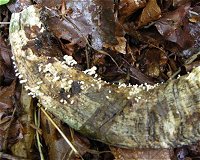
I went on the NWFG foray to Healey Dell, Rochdale. Some interesting finds before I went home. Oudemansiella mucida (Porcelain Fungus) on a large fallen Beech, which also produced many more species, large and small. Star of the day was the find of a sheep's horn (head and ribs as well) covered with Onygena equiseta (Horn Stalkball). How the sheep found its way into the wood is a mystery. I was also lucky that one of my colleagues brought me a key for Pezizas and I was able to confirm my identification of Peziza hortensis.
Monday 22nd August
Golf today. My first find was of two Calvatia gigantea (Giant Puffball) although they were not very 'giant'. Also growing were Suillus grevillei (Larch Bolete), Lacrymaria lacrymabunda (Weeping Widow) and a nice, edible collection of Agaricus campestris (Field Mushroom).
Tuesday 23rd August
I was invited by a colleague to look for Phallus hadriani on the Birkdale Dunes, where I know it grows. Sadly, we did not find any. But I did find Hygrocybe conicoides (Dune Waxcap) which has larger spores than the more common H. conica. Also Psathyrella ammophila (Dune Brittlestem), Inocybe serotina AND a most probable Stropharia halophila (only 3 previous records). All of these species are sand dune specialists. Methinks the reason that they are rare or uncommon is that so few people are looking for them. After over 2 hours tramping up and down sand dunes I was exhausted.
Monday 29th August
Things are quiet at the moment. I went blackberry picking but only found a few Marasmius rotula (Collared Parachute) at the side of a footbal field and a solitary Entoloma conferendum (Star Pinkgill) grew on my lawn.
Tuesday 30th August
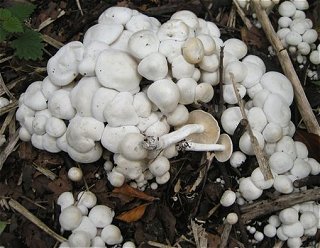
I went for a quick walk round my local golf course, dodging the showers. Only a few slug eaten Russulas to start but then nothing until I found four large patches, numbering 100 plus, of Lyophyllum connatum (White Domecap). They were growing on soil where a large Beech tree had rotted away. I have not found this on Merseyside before. There are only 15 records for South Lancaster on the BMS Database.
Monday 12th September
Just returned from holiday in Bourdeaux. Beautiful place. Good restaurants. I had my garlic mushrooms. Had a look at the local golf course and managed to find Laetiporus sulphureus (Poulet des Bois) growng from a stump. Just cannot help myself.
Tuesday 13th September
Back to gardening. I had a look for Tubaria dispersa, a regular on my allotmenr site. Nothing under it's usual host, Cratageus (Hawthorn). But there were a few small specimens under a Cotoneaster. It likes red berries.
Saturday 17th September
I led a foray for the wardens at Ainsdale Sand Dunes Nature Reserve. Eighteen poor souls turned up just as the heavens opened. It was difficult to refer to books and show people how to use them to identify fungi because it was impossible to keep them dry. I was fortunate that I know the site well and all the regular fungi I expected were there. Nothing like telling stories about Amanita muscaria (Fly Agaric) to keep an audience interested. The kids love Lycoperdon (Wolf Fart). I was glad when it ended and everyone seemed to enjoy it. May have recruited some new members with my charm.
Sunday 18th September
Joined the NWFG foray at Moore Nature Reserve. A very good day with lots of waxcaps, Hygrocybe ceracea (Butter), conica (Blackening), coccinea (Scarlet) and pratensis (Meadow) on the heathland and some intersting finds of Cortinarius bivelus, Inocybe flocculosa (Fleecy Fibrecap). The Daldinia fissa was still showing on the burnt Gorse and some more Lyophyllum connatum (Clustered Domecap). It seems to be everywhere this year. Still a few in boxes to do.
Monday 19th September
Back to golf and the fungi are at last beginning to show. Leccinum versipelle (Orange Birch Bolete), Amanita fulva (Tawny Grisette) and a couple of Calvatia gigantea (Giant Puffball) were seen. Lots of Leccinum scabrum (Brown Birch Bolete). Hopefull, it will be a good end to the year.
Tuesday 20th September
On the grass path leading to my allotment, I found two Xerocomus. Using the key from Alan Hills, they keyed out as Xerocomus, now Boletus, chrysenteron (Red Cracking Bolete). Once the most popular species of Xerocomus, this is now said to be uncommon.
Wednesday 21st September
Very interesting find at the allotments. I noticed a bracket fungus growing from a piece of timber floor board used as edging around one of the plots. It was brown, hairy and with 'gills' instead of pores. I assume the timber was conifer and the fungus is therefore Gloeophyllum sepiarium (Conifer Mazegill).
Thursday 22nd September
My golf course has erupted with fungi. Mostly Amanita musacria (Fly Agaric), rubescens (Blusher) and Leccinum Scabrum (Brown Birch Bolete). But there were a few treasures to be found. The first was of Cyathus striatus (Fluted Birds Nest) in the flowerbed, a reappearance after ten years. Then, Suillus luteus (Slippery Jack) growing with a newly planted Pine tree. A first for the site. It must have arrived with the tree. Another find was of Leccinum aurantiacum, under Populus tremela (Aspen). And to finish off I found one Boletus badius (Bay Bolete) and a boxful of Boletus edulius (Penny Bun). Interestingly, they have moved. One was at the base of an Sycamore, some under Aspen, the rest under Betula (Birch). This looks like a good omelette.
Saturday 24th September
A quick walk through a local park produced a nice group of Gymnopilus junonius (Spectacular Rustgill) on a fallen Beech but not much else. Although collections at recent forays have been very good, locally, there is very little. The ground is still quite dry. Hopefully it will be better later in the year.
Sunday 25th September

I attended the NWFG foray at Roudsea Woods in Cumbria, a long way from home. This is one of the premier sites in this region and did not disappoint. A full list will appear on the NWFG website in due course but the highlights were Cortinarius praestans (Goliath Webcap). My photo shows the size against a £1 coin. Also Amanita phalloides (Death Cap), Asterphora lycoperdoides (Powdery Piggyback), a parasite growing on rotten Russulas and some Cantharellus cibarius (Chanterelle) which I snaffled for breakfast.

Wednesday 28th September
Back to golf. Lots of fungi but nothing unusual. Another bag of Boletus edulis (Penny Bun). I did remember to take my camera and I took a photo of the Cyathus striatus (Fluted Birds Nest) which is growing in the flowerbed. The head gardener thought that they were insect eggs until I told him otherwise.
Monday 3rd October
Despite the late hot weather, the golf course is still producing fungi. Over 100 Amanita muscaria (Fly Agaric) and even more Leccinums of different species. Of interest was large group of Russula claroflava (Yellow Swamp Brittlegill). It is beautiful shade of yellow. It grew in the same place last year. Strangely, this particular part of the course is not especially wet. I am sure that it knows best.
Tuesday 4th October
I am now preparing to lead a foray at Carr Mill Dam, near St. Helens. Usually a very productive site at this time of year. I went on a scouting foray. The paths are still there but I found very few fungi. Mind you, it was the same last year. It is amazing what a few extra eyes can turn up. There were fungi about, so I am cofident that we should have a good day.
Wednesday 5th October
I played golf today. I found Inocybe napipes (Bulbous Fibrecap), so called because of the bulb at the end of the stem. This is why you should dig up Inocybes otherwise you miss the important bit. Also, a new species for the site, Laccaria tortilis (Twisted Deceiver).This very small species was growing from under the wooden edging of one of the tee areas. Just luck that I noticed it. It has large spiny spores and a two spore basidia. My Boletus edulis (Cep) - have found another site. Two more today.
Sunday 9th October
I was leader for this foray to Carr Mill Dam near St. Helens. Fortunately the heavy rain ceased and we had a very nice morning. There did not seem to be much around but the team worked hard and filled all the little boxes. Eventually the rain came just after lunchtime so we packed our bags and went home. We ended up with 106 species which makes this one of the better sites in the area. On an old firesite we found Hebeloma pumillum. Also Lanzia echinophila on the cupule of Turkey Oak. We found one of everything but nothing really special. Most of the species were very small. Most remarkable was that we did not find any Paxillus involutus (Brown Rollrim) nor any Coprinus.
Tuesday 11th October
I need to dig over the allotment and prepare for Winter. The weather has been so bad that the main paths have not been mown and have a lot of grassy growth. The fungi have taken advantage. I found Hebeloma mesophaeum (Veiled Poisonpie), Clitocybe metachroa and Bolbitius titubans (Yellow Fieldcap) on the main paths.
Sunday 16th October
My computer died last week so I have been trying to catch up having purchased a new one. Today the NWFG went to Cuerden Park, near Chorley. Some interesting species but, again, small ones. Anthracobia macrocystis on a bonfire site, Cudoniella acicularis (Oak Pin) in a Beech wood, must have been an old stump. A shortage of Russulas, only Russula cyanoxantha (Charcoal Burner) to be seen.
Wednesday 19th October
Back to golf today but it was cold and windy. After two weeks away, all the larger fungi have disappeared. A few Mycena leptoephala (Nitrous Bonnet) on the top of a sand bunker. A lot of Rhodocollybia butyracea (Butter Cap). I also found some more Scleroderma bovista (Potato Earthball). Before this year, I had never knowingly seen one. Now I have found it at three sites. It is possibly that I am more experienced with this fungus (I have got my eye in).
Thursday 20th October
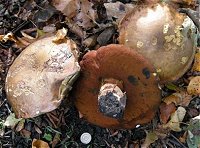
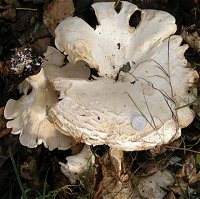
A lovely afternoon. The rain had stopped so I went for a walk round my usual sites. Today was for giants. On a dual carriageway, I came across three Boletus erythropus (Scarletina Bolete), all measured 18ms across. Then, in a local park, I found eight Leucopaxillus giganteus (Giant Funnel), at least 20 cms across. One had a swimming pool in the centre. Then the complete opposite, Marasmius setosus growing on the beech leaves surrounding the Leucopaxillus. This was followed by a couple of Psilocybe cyanescens (Blueleg Brownie) by the path and then waxcaps, Hygrocybe conica (Blackening), coccinea (Scarlet) and ceracea (Butter) on the lawns. A lovely afternoon.
Friday 21st October
Another fine day, so I went for another walk through another local park, to inspect the flowerbeds mulched with a mix of woodchip and leaves in the spring. There were lots of fungi growing. Lentinellus cochleatus (Aniseed Cockleshell) was an interesting find. Then Melanoleuca brevipes (Stunted Cavalier), Russula sardonia (Prmrose Brittlegill), the deadly Galerina marginata (Funeral Bell) and Clitocybe phaeophthalma (Chicken Run Funnel) so named because it really does smell awful. However, there was a very large dark wine coloured specimen, which had been kicked over. Unfortunately it was still immature so I could not find any spores or cystidia. However colour, size and the start of a pendulous ring strongly suggest Stropharia rugosoannulata (Burgundy Slime Head). No reason why not. The substrate is right for it. I just can not prove it.
Saturday 22nd October
I went out to Ainsdale to make sure there were no problems with car parking for my foray next Sunday. Also to plan a route over Freshfield Dune Heath, which we shall look at on the way to the woods. Lots of horse riding in the area so lots of dung. They also using cows and ponies to keep the growth down. Lots of Panaeolus semiovatus (Egghead Mottlegill) and Psilocybe coprophila, both dung specialists.
Wednesday 26th October
I played golf today. Not much around. A few new growths of Leccinum duriusculum (Slate Bolete), which is normally one of the first fungi to fruit early in the year. I also found Clavaria fragilis (White Spindles). Not an unusual species but it is the first time I have found it on my golf course. Species No. 375.
Friday 28th October
I went to the horse racing at Wetherby. They have a large expanse of grass for the public to walk on and watch the racing. Surprisingly few fungi. Only a couple of Coprinus comatus (Lawyer's Wig) and a few unidentifiable Mycenas (Bonnets).
Sunday 30th October
It was beautiful weather for my foray to Formby. I had intended to spend 30 minutes on Freshfield Dune Heath, gorse, heather and lots of weathered dung from grazing animals. We were still there two hours later, so productive was our search. Collybia cirrhata (Piggyback Shanklet) on rotting fungi, Lycoperdon nigrescens (Dusky Puffball), Psilocybe coprophila and lots of different little brown jobs on the animal dung. After lunch we moved over to Ainsdale woods where we found numerous Crucibulum laeve (Common Bird's Nest) on a sand hill and a pine cone, the green gilled Melanophyllum eyrei (Green Spored Dapperling) and a possible Clitocybe costata, though separating this from Clitocybe gibba is a headache. Similarly the difference between Gymnopilus penetrans (Common Rustgill) and Gymnopilus sapineus (Scaly Rustgill). We even had time to look at the outer dunes, where we immediately found Inocybe dunensis buried in the sand. Three different habitats in one day makes a foray more interesting. I took home more unidentified boxes than ever before. I wish I had left the Cortinarius specimens behind!
Tuesday 1st November
I went to my allotment to pick some veg for tea. It rained heavily last night. Today there were Lepistas everywhere, on the paths, the rhubarb, rotting weeds, bare soil - everywhere. Some are big and fat so are probably Lepista nuda (Wood Blewit), some are not, so could be Lepista sordida. Another example of differences being so small it is almost impossible to differentiate between the two. Also encouraged by the weather were Xerocomellus chrysenteron, Melanoleuca grammopodia and Entoloma rhodopolium.
Wednesday 2nd November
Golf today. I hit a really bad one which was lucky to stay on the course. Six inches from my ball is a lone Lepista saeve (Field Blewit). Not unusual but another first for my golf course. Species No. 376. Also Cortinarius flexipes var. flabellus (Pelargonium Webcap) Species No 377. Could be a good early winter.
Friday 4th November
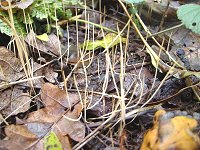
I joined my group for a private visit to Rostherne Mere near Altrincham. The Mere is fringed with Phragmites beds and is very wet. The tiny Marasmius limosus was found on some dead stalks and nearby woods yielded Marasmius cohaerens, Macrotyphula juncea (Slender Club), Aleuria aurantia (Orange Peel), Ampulloclitocybe clavipes (Club Foot) and lots of boxes. Some of us found time to take a quick look round the local churchyard where we found a number of the more common grass loving fungi.
Sunday 6th November
As it was a nice afternoon, I popped up to the local park to see if anything had grown on the flowerbeds. They were alive with hundreds of Psathyrellas, mainly corrugis (Red Edge Brittlestem. Also lots of Melanoleuca pilioleuca (Common Cavalier). An unusual find was of Pleurotus ostreatus (Oyster Mushroom) growing from the mulch as a rosette. I also found a large Conocybe (Conecap), with a 5cm cap and long necked capitate cystidia which I can not identify. This is a difficult genus anyway but having found two foreigners on these beds this year, I can not even speculate what it might be. Frustrating.
Wednesday 9th November
Popped up to my allotment to pick some veg for tea. A quick look in our orchrd yielded a couple of Agarics silvaticus (Blushing Wood Mushroom) under the pear tree. A first for the site. Plus lots of Entoloma rhodopolium (Wood Pinkgill). I thought they might be something else but I only found one clamp connection in the cap. Then off to golf where I collected Galerina clavata, Mycena luteoalba and Hebeloma mesophaeum. No English names for any of these although they are fairly common. And I won at golf. A busy day.
Thursday 10th November
Another nice warm day so I popped down to Speke Hall. Lots of waxcaps, Hygrocybe laeta (Heath), pratensis (Meadow) and virginea (Snowy) on The Great Lawn with Clavulinopsis helvola (Golden Spindles). Under the pines were Suillus luteus (Slippery Jack) and Lactarius deliciosus (Saffron Mlkcap). Lots of species but all standard fare. Nothing unusual.
Friday 11th November
I went back to Speke Hall to see if I could find Cystoderma jasonis which grows with Calluna (heather) and pines. The Great Lawn there has a heather feature in the middle with pine trees by the side. I took a dozen specimens but they were all Cystoderma amianthinum (Earthy Powdercap). Driving down a dual carriageway on my way home I saw some large fungi on the central reservation. I stopped and found eighteen Boletus edulis (Penny Bun). I measured most at over 20cms. Sadly they were all well past their best. Why did I not find them earlier? Very late for this species which confirms that it is much warmer than usual.
Saturday 12th November
This time last year it was frosty. This morning warm sunshine. Taking advantage I went for a walk. Russula fellea (Geranium Brittlegill) and Russula parazurea (Powdery Brittlegill) under the beech trees. Huge numbers of Chlorophyllum rhacodes (Shaggy Parasol) everywhere. After last weeks high winds, the fallen leaves lie thick on the ground so I was very lucky to spot Mycena speirea (Bark Bonnet). A lot of the fallen wood is showing small signs of growth so it could be an interesting winter.
Sunday 13th November
This afternoon I went to Sudley Hall, formerly the home of a shipping magnate. It has a modest garden with a small piece of woodland attached, mainly beech. Within 30minutes I had found over 30 species. Good finds were Tricholoma scalpturatum (Yellowing Knight), Russula aeruginea (Green Brittlegill), Cortinarius anomalus (Variable Webcap) and Cortinarius ochroleucus, an unusual white coloured Webcap which took some effort to identify.
Monday 14th November
Golf this morning and the weather has gone colder. I did manage to find a pretty collection of Hygrocybe aurantiosplendens (Orange Waxcap). As I was playing well I did not have time to take a photo.
Tuesday 15th November
Yet another nice day. This time last year was frosty. I took advantage to try a previously unvisited pinewood area of a local park, actually the entrance to the Crematorium. I was rewarded with Lactarius deliciosus (Saffron Milkcap), Suillus granulatus (Weeping Bolete) and Agaricus silvaticus (Blushing Wood Mushroom). Lots of Clitocybe metachroa and Lepista flaccida(Tawny Funnel). Walking back through the beech area, I was able to compare a Pholiota squarrosa (Shaggy Scalycap) with Pholiota aurivella (Golden Scalycap) growing on the next tree. Oh joy. Another site for Boletus edulis (Penny Bun). This the third new site I have found this week. All under beech. All large specimens. Earlier in the year I find this fungus under birch and much smaller, perhaps because it is drier weather then.
Wednesday 16th November
Golf today. It was bitterly cold in the wind. The odd Mycena flavoalba (Ivory Bonnet) and Mycena aetites (Drab Bonnet) but nothing interesting until the 13th Hole, where, under one of the trees I found a sweet-soapy smelling specimen. A brown spore print and a look under the microscope showed it was clearly a Hebeloma, and the conclusion is Hebeloma sacchariolens (Sweet Poisonpie). A first for the site. Nice to find something new.
Saturday 19th November
Another nice day. Another walk in the woods, this time at Hale Hall. I did not take enough boxes. Agrocybe rivulosa on a woodchip pile, Agaricus urinascens (Macro Mushroom) at the edge of the woods, Pluteus plautus (Satin Shield), Lepista saeva (Field Blewit but not in a field) and Peziza micropus. But the star of the show was a collection of Rhodotus palmatus (wrinkled Peach) on the same fallen tree I found it on three years ago.
Tuesday 22nd November
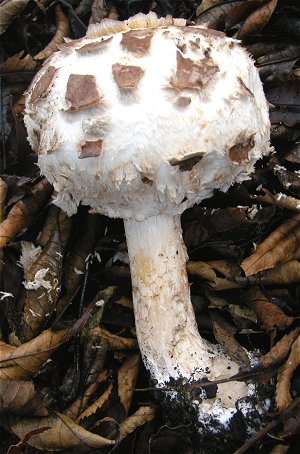
In view of the nice weather I went back to my local park to see if anything new had grown. Lots of fungi but I had seen most of them before. Hundreds and hundreds of Psathyrellas but they all keyed out as Psathyrella microrhiza (Rootlet Brittlestem). I thought there might be something different. Having identified all the same fungi as the last time I visited, I was excited to find a Macrolepiota (now Chlorophyllum) rhacodes, except that this was variety brunneum. The last time I saw this was in the Sefton Park Palm House. The interesting thing is that this part of the Park is adjacent to the Council Compost Facility where they process all the green waste from homes and parks. So anything could grow from this compost mulch.
Wednesday 23rd November
Golf today. The fungi have started to grow again. All the regulars were present. A new find for this site was of a large group of Pholiota gummosa in an area which was recently cut down and replanted. I have passed this spot twice a week for over forty years. Where has this fungus been hiding for all that time?
Friday 25th November
The weather has suddenly changed to cold and windy. I went to Sefton Park, an area which has produced lots of fungi at this time of year. Today I recorded a zero. Is this the end of the foray season?
Saturday 26th November
I was at my vegetable allotment when I noticed a small group of Hypholoma fasciculare (Sulphur Tuft) growing from the soil beside my plum tree. This is the second year running and in the same place. Is my plum tree on its way out?
Monday 28th November
Golf today. Alongside our practice area is a line of youngish trees, 2 oaks and 4 beeches, about 12feet apart. Each tree supports a different species of fungus. Cortinarius anomalus (Variable Webcap) under a beech, then Lactarius quietus (Oak Milkcap), Clavulina rugosa (Wrinkled Club), then Russula fragilis (Fragile Brittlegill)and Laccaria laccata (Deceiver). The most interesting was a find of Hygrophoropsis aurantiaca (False Chanterelle) but not under conifer or birch but under beech. Highly unusual.
Thursday 1st December
Nothing much at the golf course. I managed to find one Peziza growing right on the edge between some paving stones and a flowerbed . These are fairly difficult to pin down as a number have similar spores, in this case smooth. As the substrate was not certain, I had to rely on the fact it had a smaller spore than the rest and other microscopic detail to reach the conclusion of Peziza cerea (Cellar Cup).
Friday 2nd December
Another nice day. How long will this last? A quick walk around the local golf course where they have piled up all the fallen timber into one place. Mycena adscendens (Frosty Bonnet) on some rotting wood and Crepidotus epibryus on grass stems and litter. Lots of Melanoleuca polioleuca (Common Cavalier) and an increasing group of Lyophyllum connatum (White Domecap) on a pile of leaf mould.
Monday 12th December
After ten days of wind, rain and hail, the sun came out though not for long. I went up to my local golf course and was surprised that the fungi had withstood such weather. Lots of Lepista flaccida (Tawny Funnel), some Clitocybe fragrans (Fragrant Funnel), an odd Laccaria laccata (Deceiver), a very late Amanita rubescens (Blusher) and an unidentified Russula. Two excellent finds were of a tiny Marasmius setosus on Beech litter and an equally tiny Mycena hiemalis on moss at the base of a Sycamore.
Wednesday 14th December
Golf today. Still lots of fungi about but interestingly all in the same area surrounding the practice ground. This is the most exposed part of the course yet the only part that supports fungi into winter. Found Hygrocybe pratensis (Meadow Waxcap) for the first time this year together with Clitocybe fragrans (Fragrant Funnel). I also started on the Corticioids, picking up a tree branch supporting Peniophora limitata.
Sunday 18th December
After all the gales, rain, hail and snow, the sun almost came out so I went to my allotment to make more essential repairs to my greenhouse. Despite the severity of the weather a small group of Mycena flavoalba (Ivory Bonnet) had managed to survive on one of the grass paths.
Tuesday 20th December
I managed an hour in my local park betweens showers and Christmas shopping. Over the years a good number of beech trees have been felled and the trunks, too large to remove, have been left in situ or moved to be used as barriers. It fascinates me that some of these trunks seem totally resistant to fungi while others are a treasure trove of different species. I have been visiting one such trunk for ten years. Almost every time I inspect it, something new has developed. It is now quickly disintegrating and soon will be nothing more than a mound of soil. I may write an article about this one trunk. Today a lot of new fungi were visible on some of the newer trunks. Nothing special except for a large group of Peziza micropus.
Wednesday 21st December
How the weather has suddenly changed. Golf today. I was surprised to find a group of three very large Pluteus cervinus (Deer Shield) growing from a buried stump, in the woods where my opponent had hit his ball. We did not find his ball. Then, a few holes later, protected by some Rhododendrons, I found a large group of Lepista saeve (Field Blewit). This is the second find this year of this fungus. I have never found it here before. What was I doing in the Rhododendrons? We did not find my ball either. Now you know why I find so many fungi while playing golf.
Merry Christmas.
Friday 23rd December
The problem with all this wet weather is that the fungi look so bedraggled that immediate identification becomes difficult. Now is the season of Clitocybe nebularis (Clouded Agaric). They are everywhere in my local park so I do not bother to check them all. Then a patch of fungi was kicked over and today I noticed they were all joined together. They were Lyophyllum not Clitocybe. These were quite dark with a thick cartilaginous cap so I plumped for Lyophyllum loricatum but not with confidence. I have been passing tree trunks supporting Pleurotus ostreatus (Oyster Mushroom) for some weeks until today I noticed that one group looked very green when wet. They were not Pleurotus but Sarcomyxa serotina (Olive Oysterling). Must try harder.
Saturday 24th December
Walking round my local park I came across a group of Lepiota aspera (Freckled Dapperling) growing on a small mound, probably where prunings and other vegetation had been dumped over the years. On the other side of the mound was a couple of very bedraggled and soggy orange coloured fungi. I would have ignored them but for the fact that one of the stems had an obvious sheath. I managed to salvage a bit with decent gills. At home, having found some spores, I took a section from the cap which revealed lots of balloon shaped cells. My conclusion is Phaeolepiota aurea (Golden Bootleg). An excellent Xmas present.
Monday 26th December
Taking advantage of the mild weather I am trying to visit all of my regular sites before winter sets in. Today was the turn of some woods down by the River Mersey, once the gardens of a great hall, now demolished. Still lots of fungi around. The most notable find was of Lepista irina (Flowery Blewit), white and sweet smelling. Interestingly, I have now found three different Lepistas, nuda and seava, in these woods in the space of two weeks. Another interesting find was of the purple Ascocoryne cylichnium (Purple Jellydisc Mark 2), which can only be separated from A. sarcoides by the long, torpedo shaped spores.
Tuesday 27th December
Had a look at a wood I rarely visit. Despite the mature beech trees it does not produce many fungi. It is also very popular, lots of children and dogs. I saw lots of the various common bracket fungi. I was fortunate to come across an lone Conocybe vexans, one of those with a tiny ring on the stem. The other find, new to me, was of Psathyrella spadicea (Chestnut Brittlestem), growing at the base of a beech stump. A distinctive red-brown colour with a red-brown spore print.
Wednesday 28th December
Golf today but not for long in a howling gale. Managed to find two different species of Galerina. Galerina clavata and vittiformis (Hairy Leg Bell). Both have 4 spored basidia. G. clavata has cystidia with long necks and a round head. G. vittiformis does not have cystidia with a head but it does have a white hairy base to the stem. Not easy these, even with a microscope. I also found a very hardy Russula ochroleuca (Ochre Brittlegill).
Friday 30th December
We played golf early this morning, before the mowers went out. I was surprised to see a large group of Melanoleuca in the short grass on the first tee. I makes me wonder what else might grow if the grass was not cut every day. I eventually identified them as Melanoleuca brevipes (Stunted Cavalier). The other choice was M. excissa but the large spores, short stem and thin stinging nettle cystidia persuaded me that brevipes was the correct choice.
Saturday 31st December
A final walk round my local park. Still fungi about while the weather stays mild. Under a small group of beeches I found group of Russula nobilis (Beechwood Sickener) and a couple of Russula atropurpurea (Purple Brittlegill). A couple of small species to play with this afternoon.
And that is the lot for this year.
Happy New Year to all and good foraying in the New Year.
